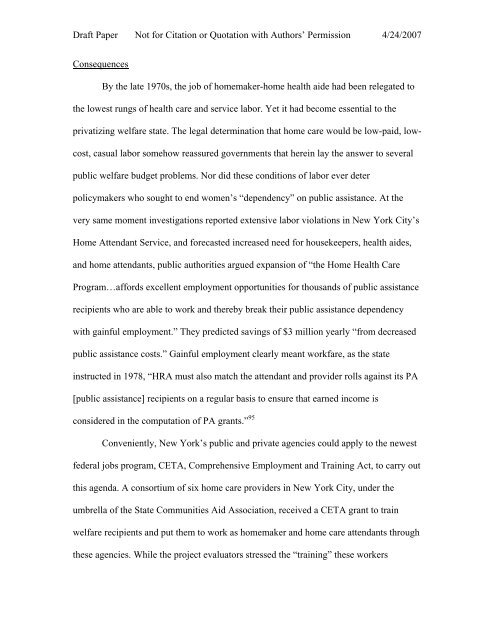Organizing Home Care: - School of Social Service Administration
Organizing Home Care: - School of Social Service Administration
Organizing Home Care: - School of Social Service Administration
You also want an ePaper? Increase the reach of your titles
YUMPU automatically turns print PDFs into web optimized ePapers that Google loves.
Draft Paper Not for Citation or Quotation with Authors’ Permission 4/24/2007<br />
Consequences<br />
By the late 1970s, the job <strong>of</strong> homemaker-home health aide had been relegated to<br />
the lowest rungs <strong>of</strong> health care and service labor. Yet it had become essential to the<br />
privatizing welfare state. The legal determination that home care would be low-paid, lowcost,<br />
casual labor somehow reassured governments that herein lay the answer to several<br />
public welfare budget problems. Nor did these conditions <strong>of</strong> labor ever deter<br />
policymakers who sought to end women’s “dependency” on public assistance. At the<br />
very same moment investigations reported extensive labor violations in New York City’s<br />
<strong>Home</strong> Attendant <strong>Service</strong>, and forecasted increased need for housekeepers, health aides,<br />
and home attendants, public authorities argued expansion <strong>of</strong> “the <strong>Home</strong> Health <strong>Care</strong><br />
Program…affords excellent employment opportunities for thousands <strong>of</strong> public assistance<br />
recipients who are able to work and thereby break their public assistance dependency<br />
with gainful employment.” They predicted savings <strong>of</strong> $3 million yearly “from decreased<br />
public assistance costs.” Gainful employment clearly meant workfare, as the state<br />
instructed in 1978, “HRA must also match the attendant and provider rolls against its PA<br />
[public assistance] recipients on a regular basis to ensure that earned income is<br />
considered in the computation <strong>of</strong> PA grants.” 95<br />
Conveniently, New York’s public and private agencies could apply to the newest<br />
federal jobs program, CETA, Comprehensive Employment and Training Act, to carry out<br />
this agenda. A consortium <strong>of</strong> six home care providers in New York City, under the<br />
umbrella <strong>of</strong> the State Communities Aid Association, received a CETA grant to train<br />
welfare recipients and put them to work as homemaker and home care attendants through<br />
these agencies. While the project evaluators stressed the “training” these workers
















